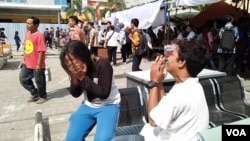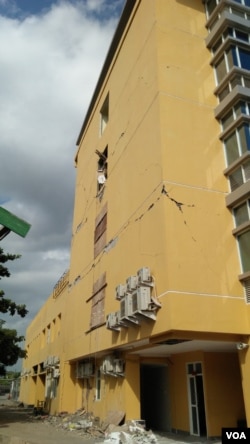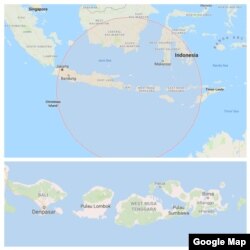A magnitude 6.2 earthquake rocked Indonesia's Lombok island and the neighboring island of Bali on Thursday, causing instant panic after Sunday's quake in the region killed more than 300 people.
People at Bali's Ngurah Rai International Airport were seen shouting and running down escalators, streaming out the exits and across the main hall.
Officials said the epicenter of the aftershock was on land and there was no risk of a tsunami.
Meanwhile, the death toll in Sunday's devastating earthquake on Indonesia's Lombok Island has risen to 347, the state-run Antara news agency reported.
Sutopo Purwo Nugroho, a spokesman for the country's National Disaster Mitigation Agency (BNPB), told the news agency Wednesday that another 1,447 people were injured and more than 165,000 have been displaced.
The numbers have increased as reports came in from areas isolated by the 6.9 magnitude quake, which struck off the waters of the northern part of Lombok island. The quake was also felt on the neighboring Gili Islands as well as Bali, Sumbawa and parts of East Java
Most of the displaced residents are in the island’s northern region, which was most severely affected. Hundreds of thousands of refugees are living in plastic tents erected in empty lots, yards and rice fields. Very few people are staying at the refugee centers.
BNPB reported that as of Wednesday afternoon 42,239 housing units has been declared damaged.
In Pemenang County, the area hardest hit, Muhammad Ulil Huda, a resident volunteering at the refugee command post, criticized the government's response.
"The problem is that many of our residents, victims of this earthquake, have received very little assistance,” he said. “So we must act and find and give them assistance they need."
Among the displaced are Fauzi, his wife, sons, daughters-in-law and a baby. As of Wednesday night, all seven family members jammed into a small roadside hut, a few kilometers from the tourist area of Senggigi Beach. For their family dinner they ate rice, instant noodles, tempeh and fried fish, freshly caught from the sea.
"These are from private individuals,” Fauzi said of the meal pieced together from contributions from Chinese-Indonesians, Arab-Indonesians and westerners. “Random strangers are giving us food. But no aid from the government yet.”
On August 6, the morning after the first earthquake President Joko Widodo said that "As for logistics, last night I have instructed to send assistance to West Nusa Tenggara province, including medical doctors."
But the people the Indonesian Service interviewed have not yet seen action from the government to assist them.
Kusmayadi from the volunteer organization Aksi Cepat Tanggap (ACT, or Fast Response Team) said “The province of West Nusa Tenggara has never been hit by a major disaster, so when this happened, the government is almost paralyzed. “On top of that, the earthquake destroyed a large part of the infrastructure and the government itself was affected” so much of the response infrastructure isn’t working.
Thousands of tourists have been evacuated from Lombok and the Gili Islands.
Nugroho says the death toll is expected to rise as search and rescue crews reach more affected areas and begin to search the rubble for more victims.
Last week, 17 people were killed when a 6.4-magnitude earthquake hit Lombok.
Like Bali, Lombok is known for its pristine beaches and mountains.
Indonesia is prone to earthquakes due to its location on the Pacific "Ring of Fire,'' an arc of volcanoes and fault lines in the Pacific Ocean Basin. In December 2004, a magnitude-9.1 earthquake off Sumatra island triggered a tsunami that killed 230,000 people in a dozen countries.
VOA's Indonesian service contributed to this report.


